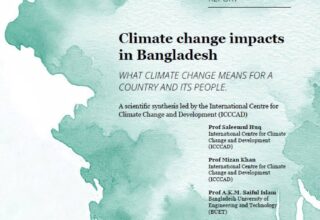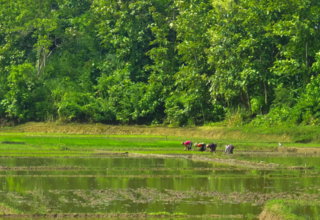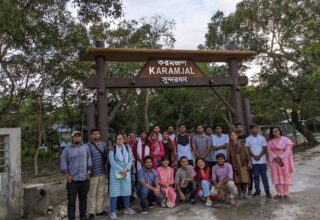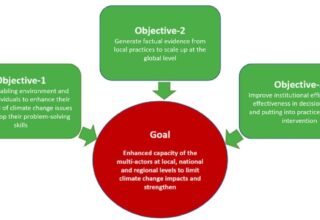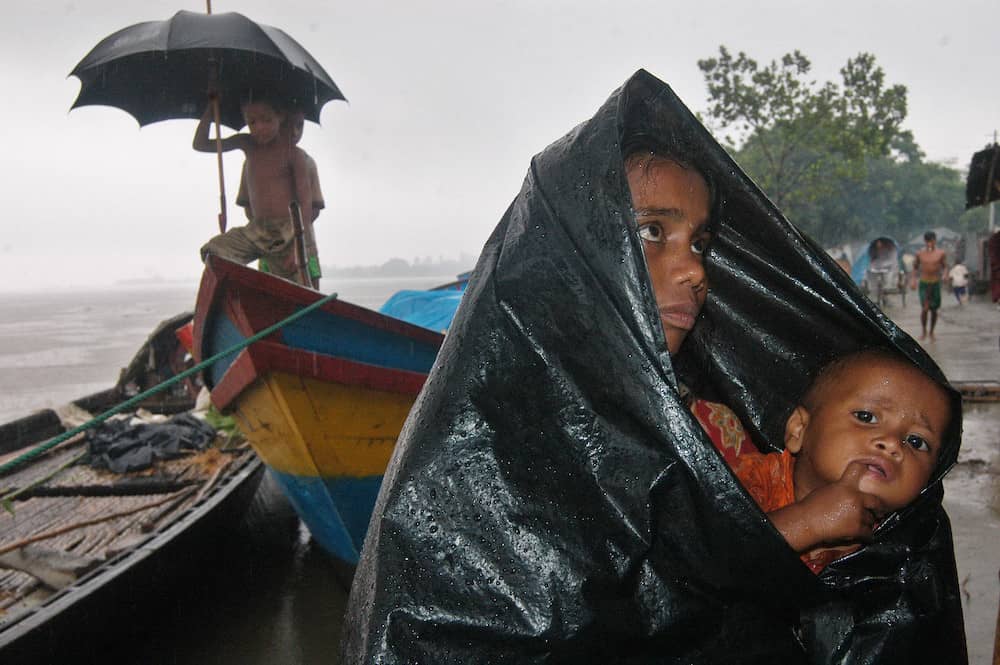
“I never preferred to migrate to the city, but the disaster, the poverty pushed me towards the city. But the city that saved me from starvation never gave peace.”- Yeasmin Begum (30) used to live at Miar Char village of Badaghat south union of Sumanganj district of Sylhet division. She migrated to Dhaka due to constant rain and upstream waters inundating her village(origin), especially from June to September, yet she dreams to go back to her roots. Similar to Yesmin, a shocking number of individuals are being affected by a number of weather-related hazards. The 2019 flood-impacted people in 21 districts in Bangladesh; affecting an estimated 580,000 people and displacing more than 307,000 people. While climate change might not be the primary factor of displacement or migration, in many cases increased frequency of disasters (e.g., Floods, Cyclones, River Erosion, Sea Level Rise, Salinity Intrusion, rising Temperature, Drought, Changing Precipitation) have heavily influenced the migration decision of people living at the frontlines of the climate crisis.
The recently released IPCC Working Group II report on impacts, adaptation, and vulnerability reiterated the stark realities of human-caused climate change, as well as how global inaction can cause displacement and distress migration. As climate change impacts and associated disasters are on the rise, a staggering number of people are being displaced or forced to migrate. Subsequently, there is a lack of data on migration and the resulting suffering of populations forced to relocate. These climate change issues have a wide-ranging impact, resulting in significant economic and agriculture losses; but other sectors such as health, livelihoods, and infrastructure are also threatened.
As this issue is becoming increasingly alarming, we must deepen our understanding of the current scenario as well as anticipate the future threats of climate-induced displacement. In this regard ActionAid Bangladesh has been working to understand displacement and migration in the country since 2012, from exploring the causes, and consequences of climate hot-spots in Bangladesh; to addressing Climate-induced Displacement and Migration in Bangladesh from Human Rights-Based Approach (HRBA). Between September 2019 and November 2020, ActionAid Bangladesh, with support from ActionAid International and Climate Action Network South Asia (CANSA), identified people-centred solutions to address displacement and migration caused by climate change. Five climate hotspots – Khulna, Chattogram, Sunamganj, Naogaon, and Dhaka were assessed for the research. When approaching climate change from a human rights perspective, the principles of universality and non-discrimination are highlighted- emphasizing that all people have rights, particularly vulnerable groups. ActionAid Bangladesh believes that through HRBA, displacement, and forced migration can be avoided by building the absorptive, adaptive, and transformative capacity of people, society, the institution, infrastructure, and the environment. The research focused on communities’ origins and destinations and how climate change has a significant impact on the migration decisions made by the impacted communities. The primary motivator for migration is the loss of livelihood, which is exacerbated by climate change. Women and men continue to face significant challenges in addressing the effects of climate change on their livelihoods due to a lack of diverse skills.
This research identified some of the key policy and programme actions from a human rights perspective, those findings and details from the study were communicated and shared with the wider research community, practitioners and policy makers attending the Gobeshona Global Conference-2.
Some key messages and takeaways from the research sharing and discussion were;
Ensure Basic Rights and Services: The adequacy and effectiveness of basic rights and services, as well as immediate responses and early recovery assistance to shocks and stresses, continue to be critical factors for communities in deciding whether to migrate.
Collaboration within governments and philanthropic organizations is needed to develop a coherent plan based on evidence-based research, coordinated planning, and investment.
Non-governmental organizations (NGOs) should collaborate with government agencies to support climate migrants and work toward a solution to protect their rights and avoid exploitation by ensuring the right to life and personal security to ensure a safer destination.
• Establish a Community-Led Protection System: as an effective means of preventing violence against women and children, particularly during and after a disaster. Furthermore, people, particularly young people, can be equipped to respond to disasters.
• Introduce Universal Social Protection: This goes beyond the Social Safety Net Program and adopts the Universal Social Protection system, which includes livelihood generation, social insurance, and a social safety net to address climate-related loss and damage, thereby reducing displacement and migration.
Effective Disaster Risk Reduction and Climate Change Adaptation Investment: The number of climate-change-related disasters increase the loss and damage to assets and livelihoods. It is therefore critical to ensure the adequacy and effectiveness of investment in reducing the risk of climate-related disasters and assisting communities in adapting to climate change.
South Asia’s National Adaptation Plans (NAP) and Nationally Determined Contributions (NDC) should include a chapter on climate-induced displacement to emphasise the cause.
Humans should have the right to mobility, and we must ensure a safer transition for climate-induced migrants by identifying and supporting their vulnerability. In this time of climate change, we must give them the freedom to choose their destination
• The establishment of a Multipurpose Information Centre will assist displaced communities in making informed decisions about whether to migrate and, if so, where to migrate.
• It is critical to continue investing in the skill development of the most vulnerable communities, particularly young women, and men. Furthermore, investment in job creation at the local and district levels must be increased.
Establish a financial architecture, which includes a registry system and a joint monitoring task force, to account for all climate investments and ensure their effectiveness. This will reduce the loss and damage caused by climate change, as well as the risk of displacement and migration. While sectoral approaches are important, strategies and actions must be able to meet the needs of people living in poverty and exclusion while ensuring equity, justice, and fairness in addressing climate-induced displacement and migration. These actions need to be gender-responsive and inclusive to all races and ethnicities as well.
Originally this article was published on August 04, 2022 at Dhaka Tribune.
Rukhsar Sultana is working at ActionAid Bangladesh as a Programme Officer at Resilience and Climate Justice Programme her research interest lies in Migration and Climate Adaptation. Can be reached at rukhsar.sultana@actionaid.org

